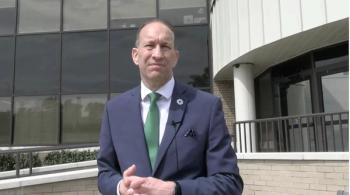
Leaders of a new cancer center, which is part of JFK University Medical Center, discuss how they can support frontline clinicians.

Your AI-Trained Oncology Knowledge Connection!


Leaders of a new cancer center, which is part of JFK University Medical Center, discuss how they can support frontline clinicians.

Panelists discuss how a multimodal frontline treatment approach for epithelioid sarcoma (ES)—combining surgery, radiation, and systemic therapies—should be tailored to tumor resectability, disease stage, and patient-specific factors such as molecular characteristics and overall health.

CAR T-cell therapy initially developed for mantle cell lymphoma was subsequently assessed in marginal zone lymphoma.
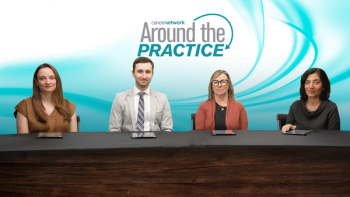
Panelists discuss how optimizing tarlatamab administration requires effective multidisciplinary team collaboration, with oncology, pharmacy, neurology, and nursing coordinating on treatment plans, patient monitoring, and adverse event management to ensure consistent, comprehensive care.

Panelists discuss how the administration of tarlatamab requires thorough pretreatment screening, staff training, and close monitoring for immune-related adverse effects such as cytokine release syndrome, emphasizing the importance of patient education, rapid intervention, and specialized infrastructure for safe and effective treatment.

The efficacy of the BOVen regimen in chronic lymphocytic leukemia facilitated its evaluation in patients with mantle cell lymphoma.

Panelists discuss how the standardized COCOON regimen offers clear guidance for managing dermatologic adverse effects, with specific components such as clindamycin lotion for the scalp and chlorhexidine wash for nails showing effectiveness.

Panelists discuss how patients have been receptive to the proactive management approach that effectively reduces dermatologic adverse effects, despite initial concerns about adding multiple prophylactic interventions.
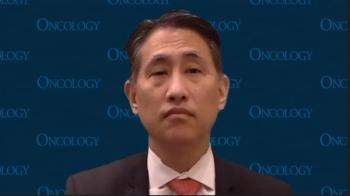
Beta emitters such as lutetium Lu 177 rosopatamab may offer built-in PSMA imaging during the treatment of patients with metastatic castration-resistant prostate cancer.
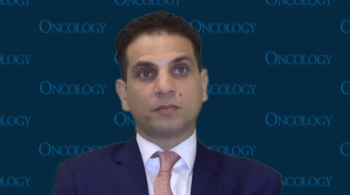
Results from cohort 4 of the phase 2 SunRISe-1 trial showed TAR-200 elicited a 6- and 9-month DFS rate of 85.3% and 81.1%, respectively, in BCG-unresponsive NMIBC.

Ongoing ctDNA analysis may elucidate outcomes associated with divarasib plus migoprotafib for those with KRAS G12C–positive NSCLC.
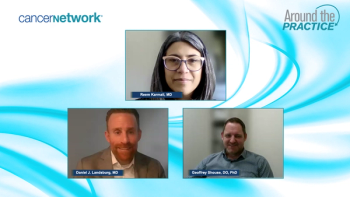
Panelists discuss how evaluating zanubrutinib in combination with obinutuzumab involves considering patient comorbidities, disease characteristics, and previous treatments, with a focus on tolerability, adverse-effect profiles, and patient preferences to guide optimal treatment choices.

Panelists discuss how research on circulating tumor DNA (ctDNA) testing in colorectal cancer requires careful consideration of standardized collection protocols, analytical validation, clinical utility assessment, integration with existing biomarkers, and longitudinal monitoring to establish its role in personalized treatment decision-making.

Panelists discuss how the updated NCCN Guidelines now recommend tazemetostat for the treatment of advanced epithelioid sarcoma, regardless of EZH2 mutation status, based on clinical trial data showing significant clinical benefits and improved progression-free survival in patients with both mutated and non-mutated disease.

Panelists discuss how circulating tumor DNA (ctDNA) testing serves as a complementary tool to traditional imaging in challenging colorectal cancer cases, offering molecular-level insights that can detect disease recurrence earlier, resolve ambiguous radiographic findings, and inform treatment decisions when conventional assessment methods yield inconclusive results.

Workplace burnout in medicine and oncology can lead to stress, exhaustion, fatigue, and a lack of interest in work, according to Eric P. Winer, MD.

Panelists discuss how neoadjuvant and adjuvant therapies, including chemotherapy and radiation, are used in localized epithelioid sarcoma (ES) to optimize surgical outcomes, reduce recurrence risk, and tailor treatment based on tumor characteristics and patient factors.

Panelists discuss how PSMA PET imaging is expected to evolve, enhancing precision in prostate cancer treatment through improved detection and staging. Medical professionals anticipate broader use in therapy guidance, with future advancements addressing gaps in early detection and metastasis, improving treatment strategies.

Panelists discuss how overcoming resistance mechanisms in EGFR-mutated non–small cell lung cancer (NSCLC) remains a key unmet need, with future research focusing on targeting these mechanisms, exploring new drug combinations, and optimizing treatment sequences to improve patient outcomes.

Panelists discuss how the adverse effect profile of amivantamab plus lazertinib (ami-laz) compares with other combination therapies, emphasizing its balance between therapeutic efficacy and quality of life, and how this influences decision-making in treatment selection.

Panelists discuss how, Copper-64 (^64Cu)–labeled PSMA-targeted PET imaging is emerging as a promising modality in prostate cancer diagnosis. The phase 2 SOLAR study (NCT05653856) demonstrated that ^64Cu-PSMA I&T PET/CT effectively detects metastatic prostate cancer, meeting primary end points related to correct localization rates. Compared with gallium-68 (^68Ga) and fluorine-18 (^18F), ^64Cu offers a half-life of approximately 12.7 hours, facilitating centralized production and distribution, which may improve accessibility

Panelists discuss how a real-world case of epithelioid sarcoma (ES) highlights the critical role of early recognition, comprehensive diagnostics including INI1 testing, and a multidisciplinary approach to personalize treatment based on disease extent, tumor location, and molecular features.

Eric P. Winer, MD, said, “[Health care] has a workforce problem, which is part of the reason why we need to embrace nurse practitioners and PAs or APPs.”

Panelists discuss how upcoming studies at ASCO 2025 could change practice in kidney, bladder, and prostate cancer, highlighting research on novel drug combinations, biomarkers, organ-sparing approaches, and AI-driven treatment selection.

Panelists discuss how the evolving landscape of adjuvant therapy in kidney cancer, including targeted therapies and immunotherapy like pembrolizumab, offers curative potential for high-risk patients, with a focus on risk stratification, treatment sequencing, and managing recurrence while weighing benefits and toxicities.

Panelists discuss how first-line chemoimmunotherapy has become the standard for extensive-stage small cell lung cancer (ES-SCLC) based on trials such as IMpower133 and CASPIAN, while emerging agents such as DLL3-targeted therapies show promise in the relapsed setting, highlighting the need for personalized approaches and continued clinical trial participation.

Panelists discuss how major unmet needs in extensive-stage small cell lung cancer—such as lack of durable responses, limited second-line options, absence of predictive biomarkers, and challenges managing brain metastases—underscore the urgency for more effective therapies and comprehensive supportive care strategies.

“Although telehealth is a great thing when used properly, telehealth also puts a barrier between the doctor and the patient,” said Eric P. Winer, MD.

Panelists discuss how the COCOON dermatologic management protocol significantly reduced grade 2 or higher dermatologic adverse events in multiple locations, particularly on the face/body (23% vs 62%), scalp (9% vs 29%), and nails (16% vs 21%).

Panelists discuss how the baseline characteristics of patients in the COCOON trial were evenly matched, with slightly more women than men and a significant number of Asian patients, which is typical for EGFR-mutant non–small cell lung cancer.